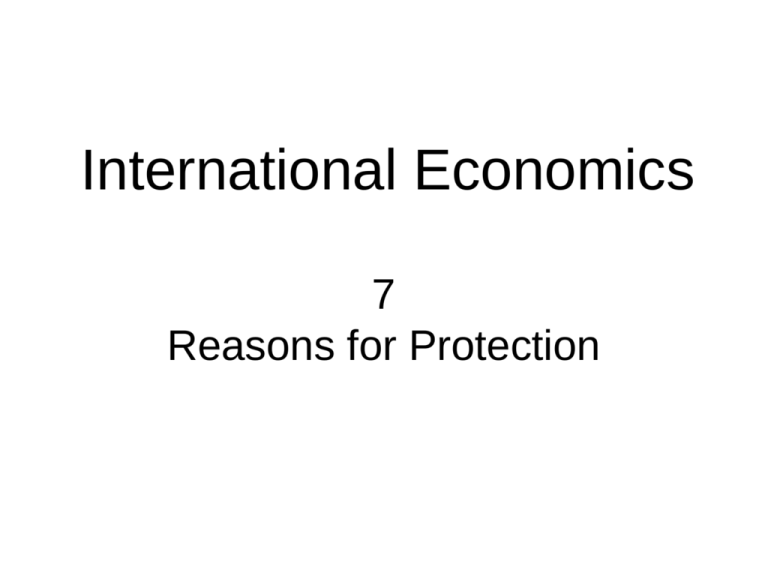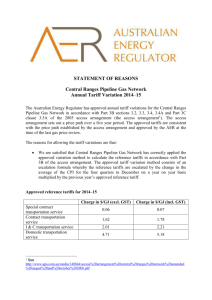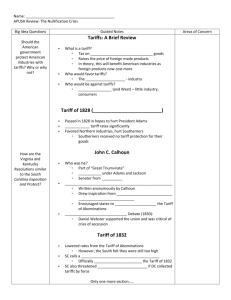International Economics - SINGGIH JATMIKO, S.Si, M.Sc.
advertisement

International Economics 7 Reasons for Protection Outline: Reasons for Protection • Reasons that DO NOT Make Economic Sense – – – – Pauper Labor Fairness Patriotism Retaliation • Reasons the DO Make Economic Sense, with Counter-Arguments – – – – – – – – Revenue Optimal Tariff Infant Industry National Security Culture Unfair Trade Protect Favored Industry Retaliation… • Production Subsidy versus Tariff • Why Aren’t Tariffs Higher? Lecture 7: Reasons 2 Why Do Countries Use Protection? • Models say that tariffs, quotas, etc. mostly hurt the countries that use them • But almost all countries do use them, and always have, even more than today. Why? • Many reasons have been given (I list 24 in my Glossary); we’ll go through some of them. • Of these, what usually explains actual protection today is Protect a Favored Industry • Why? – Benefits of protection go to a few – Costs of protection, though larger, are spread over many Lecture 7: Reasons 3 Recall Effects of Tariffs P to y l n o o g s t i f Bene e (few) th he t n i s r e c u ry d t s u pro d in d e t c prote a S b c Cost s are the ( borne b y man cons y) um e rs o f prod the u c t prote o cted f the indu stry d D Q Lecture 7: Reasons 4 Outline: Reasons for Protection • Reasons that DO NOT Make Economic Sense – – – – Pauper Labor Fairness Patriotism Retaliation • Reasons the DO Make Economic Sense, with Counter-Arguments – – – – – – – – Revenue Optimal Tariff Infant Industry National Security Culture Unfair Trade Protect Favored Industry Retaliation… • Production Subsidy versus Tariff • Why Aren’t Tariffs Higher? Lecture 7: Reasons 5 Un-sensible Reasons for Protection • “Un-sensible”? – Reasons that are based on misunderstanding of what protection will actually do Lecture 7: Reasons 6 Un-sensible Reasons for Protection • Pauper Labor Argument – “We hold that the most efficient way of protecting American labor is to prevent the importation of foreign pauper labor to compete with it in the home market…” (Democratic Party Platform, July 9, 1896) – Based on belief that trade with poor countries will drive US wages down to the very low (“pauper”) levels of poor countries Lecture 7: Reasons 7 Un-sensible Reasons for Protection • Pauper Labor Argument – Answer – See Ricardian Model: Labor in poor countries earns low wages because it is less productive than labor in rich countries. Trade will in fact raise wages in both – Caveat: Heckscher-Ohlin Model implies Factor Price Equalization (FPE) • At level above poor-country autarky wage But below the rich-country autarky wage Thus an element of truth to the pauper labor argument • But empirical evidence indicates technology differences account for much of the wage difference, preventing FPE • Thus rich-country wages may fall due to trade, but not nearly to poor-country levels Lecture 7: Reasons 8 Un-sensible Reasons for Protection • Fairness Argument – It is “unfair” to make workers compete with those who are either more productive or lower paid. – Analogy is to players in a game, who want a “level playing field” because one side must lose. • Answer – Trade is not a “zero-sum game”: There are benefits for both countries • If “field is tilted” favoring another country’s exports (e.g., by a subsidy, low wages, or cheap currency), we actually benefit from that through cheap imports. – Also, even those who lose can be compensated by others in their countries, who gain Lecture 7: Reasons 9 Un-sensible Reasons for Protection • A few years ago, I got an e-mail from something called Third Way, promoting harsher treatment of China in trade. – Their report: “China’s Trade Barrier Playbook: Why America Needs a New Game Plan” – And their graphic… Lecture 8: US 10 Lecture 8: US 11 Un-sensible Reasons for Protection • Patriotism Argument – “We should buy from producers inside our country, so that the benefit goes to them instead of to foreigners.” Lecture 7: Reasons 12 Un-sensible Reasons for Protection • Patriotism Argument - Answer – This confuses costs and benefits: in fact, buyers benefit from consumption, while sellers incur the cost of production – If we import and don’t export, then we enjoy the fruits of someone else’s labor – If we both import and export, then comparative advantage says that we (and they) both benefit more Lecture 7: Reasons 13 Un-sensible Reasons for Protection • Retaliation Argument – “If others use tariffs against our exports, then we should use tariffs against their exports.” – This assumes that their tariffs hurt us (which they do), and that we gain by fighting back • Answer – From the theory, foreign tariffs are irrelevant to the effects of our own tariffs – If using a tariff would hurt us when others do not protect, then it will also hurt us when they do – So retaliation does not help us Lecture 7: Reasons 14 Outline: Reasons for Protection • Reasons that DO NOT Make Economic Sense – – – – Pauper Labor Fairness Patriotism Retaliation • Reasons the DO Make Economic Sense, with Counter-Arguments – – – – – – – – Revenue Optimal Tariff Infant Industry National Security Culture Unfair Trade Protect Favored Industry Retaliation… • Production Subsidy versus Tariff • Why Aren’t Tariffs Higher? Lecture 7: Reasons 15 Sensible Reasons for Protection • “Sensible”? – Reasons based on effects that protection may actually have – These too have counter-arguments • Why they may not work • Why another policy would work better (that is, protection is “second best”) Lecture 7: Reasons 16 Sensible Reasons for Protection • Revenue Argument – Tariffs collect revenue for government – Tariffs may be the only tax that a weak government can manage • Tariffs are easier to collect than other taxes, because you only have to monitor the border (not the whole inside of the country) • Counter-argument: Tariff is 2nd best – – – If other taxes are feasible, then almost any other tax causes less distortion than a tariff Reason: A tariff distorts both supply and demand Example: Tax consumption… Lecture 7: Reasons 17 Recall Effects of Tariffs: Small Country • Because demanders and suppliers both are led by the tariff to behave as if the good’s value were PW+t, • P S PW+t when in fact the country can buy or sell it for PW PW. D Q Lecture 7: Reasons Revenue 18 Effects of a Consumption Tax: Small Country P • A tax on, say, consumption of the good would produce S PW+t – Less dead-weight loss – More tax revenue PW D Q Lecture 7: Reasons 19 Sensible Reasons for Protection • Optimal Tariff Argument – We saw this when we analyzed a large country: Tariff can improve the country’s terms of trade and thus raise its welfare • Counter-arguments – Optimal tariff benefits the country only at the expense of other countries • Other countries lose more than this country gains • Use of a tariff for this purpose is therefore both inefficient and unethical • It’s NOT NICE! – More practically, other countries are likely to retaliate, with tariffs of their own • Then everybody loses (probably) Lecture 7: Reasons 20 Sensible Reasons for Protection • Infant Industry Argument – When a developing country is trying to start a new industry, there are reasons why a tariff may help – We’ll discuss this further later, when we look at trade and development • Counter-argument: Protection is 2 nd best – As we will see, a direct subsidy to the industry is a less costly way of helping an infant industry (in terms of welfare, not budget) Lecture 7: Reasons 21 Sensible Reasons for Protection • National Security Arguments – Protect a military capability (e.g., steel, motor vehicles) – Reduce vulnerability to disruptions of supply (e.g., oil) – Note: Reading by Kain, which sites National Security. But his argument is not about this. We’ll see it later. • Counter-argument: Protection is 2nd best – – Direct subsidy to industry is better Other even better options also exist (e.g., stockpile the good, as in the US Strategic Petroleum Reserve) Lecture 7: Reasons 22 United States Strategic Petroleum Reserve Filled in August 2005, with 700 million barrels of oil, contained in salt caverns Compare: In 2005 US imported about 13 million barrels per day SPR could replace imports for more than 50 days Lecture 7: Reasons 23 Sensible Reasons for Protection • Cultural Argument – Imports displace products of domestic culture • French films • Canadian music – By limiting imports, distinctive domestic producers are allowed to survive • Counter-argument: Protection is 2 nd best – Direct subsidy to industry would be better – Subsidy leaves consumers free to choose: perhaps they really prefer foreign culture Lecture 7: Reasons 24 Sensible Reasons for Protection • Unfair Trade – If foreign exports are “dumped” or subsidized (thus below a “fair” price), domestic producers deserve protection – See Mastel, “Keep Anti-Dumping Laws Intact” • He cites: industrial subsidies, market collusion, government pricing, and sanctuary markets • Counter-argument: – Domestic import-competing firms do lose from “unfair trade,” but consumers in their country gain more than the firms lose, from the cheap imports – Protection is “sensible” here because it does benefit domestic producers – But here again it is second best. Lecture 7: Reasons 25 Sensible Reasons for Protection • Protect Favored Industry – Sometimes governments simply want to help an industry • To get their political support • And/or because workers in the industry are suffering – Protection (tariff or quota) certainly does help the protected industry (area “a” in our figures) • Counter-argument: Protection is 2nd best – – Direct subsidy to industry can help just as much, at lower cost Subsidy is also more transparent and easier to evaluate Lecture 7: Reasons 26 Sensible Reasons for Protection • Protect Favored Industry: Example – Reading by Kain, “Protectionism and National Security” • He believes that US should keep – Good jobs – Self-sufficiency in agriculture • Views this as a matter of morality: – “But I think a nation that’s lost its builders, its carpenters, its laborers, its blue collar workers, its middle class, becomes a nation ready for collapse. We become morally bankrupt, and literally bankrupt as well, as our entire system becomes one reliant upon debt and growth. There is a missing piece in all of this free trade econo-speak, and that is the moral element, the question of good, civil order and proportion.” Lecture 7: Reasons 27 Sensible Reasons for Protection • Retaliation – Direct effect of retaliation: Negative, as we’ve seen • Our retaliation against foreign barriers makes us worse off – Possible indirect effect of retaliation: May change behavior of foreign governments • Tariffs against “unfair” trade policies: May cause those policies to cease. • Tariffs in retaliation against optimal tariff: May cause optimal tariff to be withdrawn – WTO uses permission to retaliate as a means of enforcing its rules Lecture 7: Reasons 28 Outline: Reasons for Protection • Reasons that DO NOT Make Economic Sense – – – – Pauper Labor Fairness Patriotism Retaliation • Reasons the DO Make Economic Sense, with Counter-Arguments – – – – – – – – Revenue Optimal Tariff Infant Industry National Security Culture Unfair Trade Protect Favored Industry Retaliation… • Production Subsidy versus Tariff • Why Aren’t Tariffs Higher? Lecture 7: Reasons 29 Production Subsidy versus Tariff • Why a tariff is 2nd best for any of the above purposes that seek to increase domestic production of an industry – – – – – Compare a 50% tariff with a 50% production subsidy (small country case) Tariff raises domestic price by 50% Subsidy leaves price unchanged, but gives producers an extra 50% payment Either way, producers get 50% more for their output What are the welfare effects? … Lecture 7: Reasons 30 Compare 50% Tariff and 50% Subsidy P 50% S a PW b c Effects on Welfare Tar Sub d Sup +a +a Dem -(abcd) 0 Gov +c -(ab) Cty -(bd) -b D Q Lecture 7: Reasons 31 Production Subsidy versus Tariff • From the figure: – Net cost of tariff is Dead Weight Loss we saw before: −(b+d) – Net cost of subsidy is only −b, thus smaller – Reason: Subsidy does not distort buyers’ behavior, only sellers’ – But there is an important difference • Tariff is revenue for government • Subsidy is budgetary cost for government Lecture 7: Reasons 32 Production Subsidy versus Tariff • Alternative analysis – In Econ 101 you may have learned to analyze a subsidy by shifting the supply curve – That is equivalent to what I showed above • Production subsidy shifts supply curve enough to get the same increase in output • But be careful to use the old supply curve to measure producer surplus Lecture 7: Reasons 33 Compare 50% Tariff and 50% Subsidy P S S′ Production subsidy shifts S to S′ Effects are same as before 50% a PW b c d D Q Lecture 7: Reasons 34 Outline: Reasons for Protection • Reasons that DO NOT Make Economic Sense – – – – Pauper Labor Fairness Patriotism Retaliation • Reasons the DO Make Economic Sense, with Counter-Arguments – – – – – – – – Revenue Optimal Tariff Infant Industry National Security Culture Unfair Trade Protect Favored Industry Retaliation… • Production Subsidy versus Tariff • Why Aren’t Tariffs Higher? Lecture 7: Reasons 35 Why Aren’t Tariffs Higher? • With all these reasons for protection (albeit, not very good ones), why are US tariffs on average so small: only 2-3%? (See Magee) Lecture 7: Reasons 36 Why Aren’t Tariffs Higher? • How do reasons for protection become protection? – Politicians balance • Contributions from those who would benefit from protection against • Their perception of the benefits to society – Result is said to be “Protection for Sale” Lecture 7: Reasons 37 Why Aren’t Tariffs Higher? • Magee lists 6 possible reasons why tariffs are not higher: 1. 2. 3. 4. 5. 6. Politicians are not responsive to lobbying efforts Welfare costs of tariffs are higher than traditionally measured The GATT was successful in restraining trade barriers Free riding by firms hinders lobby organization Users of imported goods lobby against tariffs Protection is given through non-tariff barriers, which are high • Magee’s view of the evidence –. #1, 5 not important –. #2, 3, 4 play a small role –. #6 is most important: actual protection is much higher than tariffs Lecture 7: Reasons 38 Next Time • US Trade Policies and Institutions – Who handles trade policy in the US – What policies the US uses – Dumping and Anti-Dumping – Why the US Protects – Trends in US Trade Policy Lecture 7: Reasons 39






